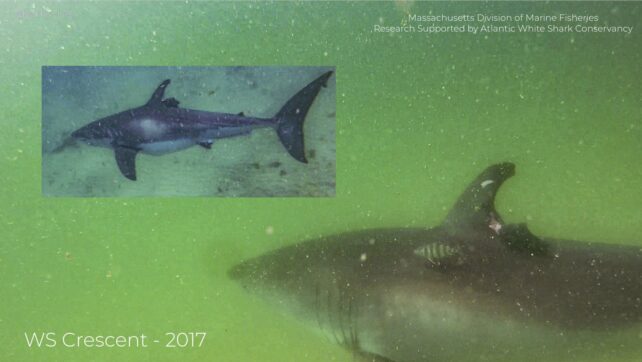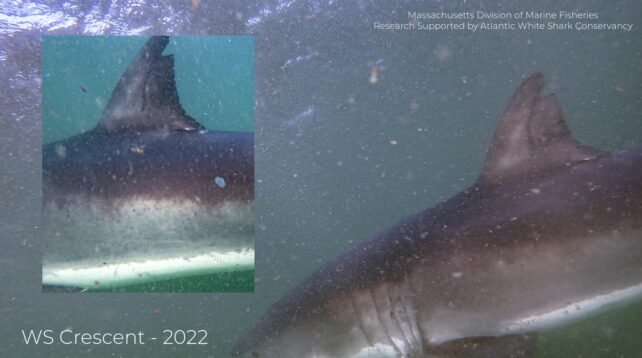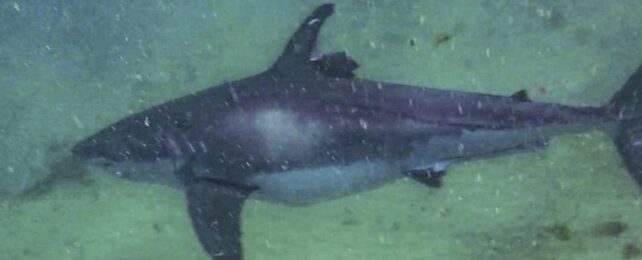Great white sharks are at the top of the ocean food chain with very few natural predators. Still, life isn't all roses for the apex predator, which still needs to cope with the rough and tumble of others of its kind.
As with many other shark species, great whites have the power to heal from some pretty ghastly wounds in an astonishingly short time and with near-surgical precision.
A great white by the name of 'Crescent' was recently seen off the coast of Massachusetts in the United States with a dorsal fin that looked as though it had been stitched back together.
Back in 2017, Crescent's dorsal fin was pictured torn right down the middle.
Researchers at the Atlantic White Shark Conservancy shared the stunning repair job on Twitter last week.
This #WhiteSharkWednesday features the ability of sharks healing. White shark “Crescent” was seen with some serious injuries in 2017 with a split dorsal fin. The research team saw him in 2022 and was able to see that his dorsal fin “zipped” back up! Incredible! pic.twitter.com/oTyRl6GlgI
— Atlantic White Shark Conservancy (@A_WhiteShark) February 8, 2023
While it's not clear what tore the shark's fin to begin with, oftentimes these injuries are due to other great whites.
When sharks copulate, things can get aggressive. Oftentimes, the male will bite onto the female to keep them close.

"Given most sharks have sharp teeth, this biting results in significant wounds to the female, which have to heal without getting infected – hence the ability to heal efficiently from wounds," shark researcher Mahmood Shivji of Nova Southeastern University in Florida told Newsweek.
But Crescent is a male. You can tell by the long appendages that sit near his pelvic fin in the full-body image above. Called claspers, these structures are used to channel semen into females during copulation.

Maybe this is why female great white sharks can have skin twice as thick as males. As male to male combat is relatively uncommon, male sharks might have the ability to heal their wounds as a byproduct of female defenses.
Or, perhaps the power of self-healing among male white sharks is a leftover from their ancestors. According to Shivji, efficient wound healing is thought to be a common trait among plenty of other sharks and rays on Earth today, which suggests it has ancient roots.
Although few species' wound healing abilities have been studied, blacktip sharks are known to be exceptionally good at healing from traumatic injuries, usually inflicted by other sharks.
Detailed reports also suggest that whale sharks can rapidly recover from extensive injuries to their skin and blood vessels, which are unfortunately becoming more common with ship strikes. In as few as 35 days, researchers say the species can heal 90 percent of tissue damage.
In comparison, reef sharks can almost completely heal combat wounds half a meter long (two feet) long within six months.
Like great whites, many of the wounds found on female reef sharks are due to copulation. Scientists actually use the look of these gradually healing wounds to predict when mating events might have occurred in the past.
Despite the remarkable defense, the evolution of shark skin is not well understood. Sharks are shy creatures and few studies have directly examined their wound-healing abilities in a controlled setting.
In fact, the genome of great whites was only investigated recently in 2019. Adaptations for wound healing were clearly evident in the results.
Such genetic flexibility coupled with mechanisms to correct possibly harmful genetic mistakes could be part of what helps great white sharks heal wounds and also avoid cancer. The species can live for up to 70 years.
"There's a tremendous amount to be learned from these highly successfully evolutionary marvels," Shivji told Business Insider in 2019.
"Their function and design is 400 million years of extremely fine-tuned evolution."
